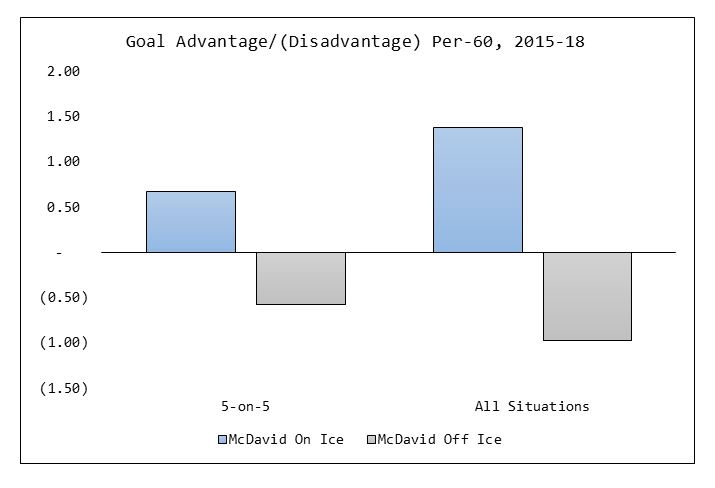Jul 30, 2019
How much can the Oilers play McDavid?
If recent goal differential trends hold, another dominating season from the star centre won’t be enough to overcome Edmonton’s dismal play when he’s on the bench, Travis Yost writes.
By Travis Yost

It will take some time to assess whether general manager Ken Holland’s plans can turn around the fate of the Edmonton Oilers. That’s one of the unfortunate realities any time an executive assumes command of a team with virtually no salary cap space in year one.
But the Oilers know they need to be competitive in 2019-20. The gift and the curse of having someone as otherworldly as Connor McDavid on the roster is that it’s a minimum expectation that his team will be competing for a championship every season.
That hasn’t been the case so far in the McDavid era. Four seasons in, we’ve seen him in the playoffs once (2016-17), and that run ended in the second round. The Oilers have been the league’s 25th best team since then, playing at a 79-point pace over the past two seasons.
It’s no secret what has killed the Oilers. The team has struggled to secure depth competency for four seasons now. Even in the 2016-17 season, where it seemed like everything was clicking across the lineup, the Oilers were still negative in goal differential at 5-on-5 (-4) and all situations (-25). But that’s far more palatable than what the Oilers did last year when the team was 34 goals in the red at 5-on-5 and 77 goals across all situations.
Over a four-year window, this is what it looks like on a per-60 minute basis:

You are reading that correctly. For every 60 minutes of ice time that McDavid hasn’t played, the Oilers fall a goal behind. It has been, in one word, stunning.
Let’s bring this back to the 2019-20 season outlook. The Oilers haven’t been able to do much with the way player payroll piled up under the previous regime, so most of Holland’s first off-season was spent tinkering at the margins.
The team retained Alex Chiasson on a two-year deal and brought in depth forwards like Markus Granlund and Tomas Jurco to soak up some bottom-six minutes. The team also has prospects like Cooper Marody, Kailer Yamamoto and Tyler Benson working their way through the ranks, but some of Edmonton’s youngsters will likely start in a developmental league due to the numbers game up front.
All in, it seems that the 2019-20 season behind the McDavid line will be a repeat of what we’ve seen historically. (Edmonton Oilers radio analyst Bob Stauffer took a stab at a projected lineup last week, and it is quite grim.)
With free agency all but over and trade options limited, the Oilers won’t be able to do much until next summer. That puts all of the attention back on McDavid. The reality for the 2019-20 team is simple: McDavid’s line needs to continue their domination over the league, but that alone won’t be enough to push this team into the postseason.
On McDavid: I don’t think his potential has been fully realized yet, which is scary. But you wonder what the ceiling is for one player when it comes to driving goal differentials. If we incorporate teammate effects, McDavid already carries the second best impact to teammate goal differential in the entire league at +0.8, trailing only Vegas Golden Knights forward Mark Stone. McDavid is easily the league leader in offensive impact, while Stone is easily the league leader in defensive impact.
You also have to wonder what the usage rate ceiling is. One of the ways to combat top-heaviness is to play into it. We see this all of the time in the postseason, where coaches who are skittish about playing their bottom six and/or third pairings tend to load up ice time for their star players. The problem for the Oilers is that we are already seeing a massive usage burden on McDavid – one that has grown with time.
McDavid has three of the 15 highest usage rates in the last four NHL seasons. In a vacuum that’s not alarming – you want your best players to see as many minutes as possible. The question worth asking: What usage rate exceeds optimal limits and what might that mean for next season? It’s a question the hockey community hasn’t quite been able to answer (for a multitude of reasons), but last year was certainly interesting from a workload perspective.
I think if you asked McDavid about last year (which, by the way, was the sixth highest usage rate in the entire modern era), he probably would concede it wasn’t his best defensive season. The Oilers gave up 3.3 goals per-60 minutes with him out there, and it wasn’t just bad goaltending – expected goals against were 3.1.
One of the things I have become curious about is if extreme usage tends to carry a detrimental effect on both shot volume and shot quality. The theory would seem rather intuitive – the more you are working, the more you will see erosion in off-puck play.
So let’s look at the heaviest usage rates we have seen since the 2007-08 season and each player’s associated impact to expected goals against. Remember: the more positive the number, the more detrimental an effect the player had on his teammate’s abilities to suppress dangerous attacking sequences against:

Absent a hellacious season from Ryan Getzlaf in 2009-10, I think you see something of a trend: the more extreme usage rates tend to have detrimental effects defensively. It’s still hard to know where to draw a line in the sand, but most of these forwards – elite, first-line talents, by and large – had an undesirable impact on the defensive side of the ice in a given season.
That’s not a slight on any of these players. In their heyday, these are some of the best attacking forwards in the league, and their respective coaching staffs understood the opportunity cost of trying to squeeze as many minutes as possible from players who were surely better options than whatever was below them in the lineup.
It brings us back to a simple math problem that’s facing the Oilers. McDavid can probably expect a usage rate at or just above 35 per cent at 5-on-5. If he carries his historical goal differentials forward at least one more year, the Oilers would be about 17 goals better than their opponents with him on the ice. And if the rest of the Oilers carry their historical goal differentials forward at least one more year, the Oilers will be about 25 goals worse than their opponent with him off the ice. They are already in the red, and that’s just at 5-on-5.
The Oilers need at least one positive wild card to help turn the tide. A monstrous penalty kill. A lethal power play. A pair of goaltenders standing on their heads. A prospect pool that explodes one year early. Without that, the depth of talent is still too shallow, and another Herculean effort from McDavid may be washed away by the bottom half of the lineup.

